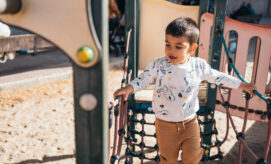From crawling and walking to running and jumping, little ones love finding new ways to exercise and move. Not only does physical movement offer young children a way to exercise and strengthen their growing bodies— it also supports their developing brains! Through movement, children learn about their body-mind connection, which is foundational to skill development in academics, communication, relationship-building, and more. In this article, we explore the benefits of movement in early childhood and the many ways that physical activity can support learning.
How Movement Supports Learning
As little ones move their bodies, they are expanding their cognitive development and learning a variety of skills that will support academic learning. ZERO TO THREE’s article, On the Move, explains that “through movement, children develop good thinking and communication skills as they explore and interact with their world. Movement also builds self-confidence. Children feel competent, physically and emotionally, when they use their bodies to communicate and solve problems.”
Early Mathematical Skills
An article for the Atlantic explains that movement allows children to connect concepts to action and to learn through trial and error. In the article, Nancy Carlsson-Paige, a professor of early childhood education, discusses the impact of playful movement and building activities on early mathematic skills: “[In an ideal early learning classroom, kids] are getting materials for an activity, they are going back and deciding what else they need for what they want to create, seeing how the shape of a block in relation to another block works, whether they need more, does it balance, does it need to be higher, is it symmetrical. All of these math concepts are unfolding while kids are actively building and moving.”
Social-Emotional Skills
Engaging in shared movement with peers can help children to form social connections with their peers. A study by Yovanka B. Lobo and Adam Winsler of George Mason University on the effects of an eight-week creative preschool dance and movement program found that children who participated in the program exhibited increased self-esteem as well as gains in teamwork and communication skills.
Communication & Language Skills
In an article for Community Plaything, author and early childhood expert Rae Pica writes, “When [children are] given the opportunity to physically demonstrate such action words as stomp, pounce, stalk, or slither—or descriptive words such as smooth, strong, gentle, or enormous—word comprehension is immediate and long lasting. (During movement activities) the words are used and learned in context, as opposed to being a mere collection of letters. This is what promotes emergent literacy and a love of language.”
Simple Ways to Incorporate Movement into Daily Routines
Many ECE professionals already incorporate movement and physical activity into their daily curriculum. Spending time outdoors, dancing to music, and playing active games are all great ways for children to move their bodies in different ways. For additional tips on incorporating movement into your ECE program routine, you might enjoy a few of the suggestions below.
- Build movement into circle time. Many of us sing songs or read books during circle time, but this part of the day can actually present opportunities to incorporate physical activity. For example, consider trying a few stretches or yoga poses to help children move their bodies in new ways. Or, add easy-to-follow dance moves to go with songs that you and the children sing together.
- Take brain breaks throughout the day. When children are doing sedentary work, such as writing or drawing, you might consider taking 1-2 minute brain breaks to allow children to jump up and down and get some wiggles out! This can feel especially good for young children, since they tend to feel particularly restless after sitting for periods of time.
- Play simple, active games. Simon Says and Red Light, Green Light are fun, interactive games that encourage children to play together, practice their listening skills, and follow directions – all while moving their bodies!
- Have dance parties. When children are particularly energetic, sometimes a dance party is the best way to get their bodies moving! Turn on some upbeat songs and encourage children to jump up and down and wave their arms up high. Dancing has the added benefit of incorporating music and creative self-expression into movement.
Additional Resources





